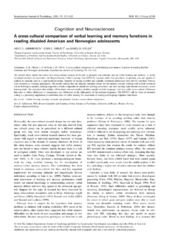A cross-cultural comparison of verbal learning and memory functions in reading disabled American and Norwegian adolescents
Peer reviewed, Journal article
Published version
Permanent lenke
https://hdl.handle.net/1956/7882Utgivelsesdato
2014-04Metadata
Vis full innførselSamlinger
Originalversjon
https://doi.org/10.1111/sjop.12108Sammendrag
The present study reports the results of a cross-cultural analysis of the role of phonetic and semantic cues in verbal learning and memory. A newly developed memory test procedure, the Bergen-Tucson Verbal Learning Test (BTVLT), expands earlier test procedures as phonetic cues are applied in addition to semantic cues in a cued recall procedure. Samples of reading disabled and typically developed adolescents from the US and from Norway were recruited as voluntary participants. The results indicate that the stimulus materials chosen for the memory test are working well in both American and in Norwegian samples, yielding acquisition results comparable to similar list learning procedures, and also yielding high internal consistency across learning trials. The procedure also reliably differentiates between reading disabled samples in both languages, and also yields cross-cultural differences that seem to reflect differences in transparency and differences in the orthography of the included languages. The BTVLT with its focus on phonetic coding is a promising supplement to established tests of verbal memory for assessment of reading and language impaired individuals.

